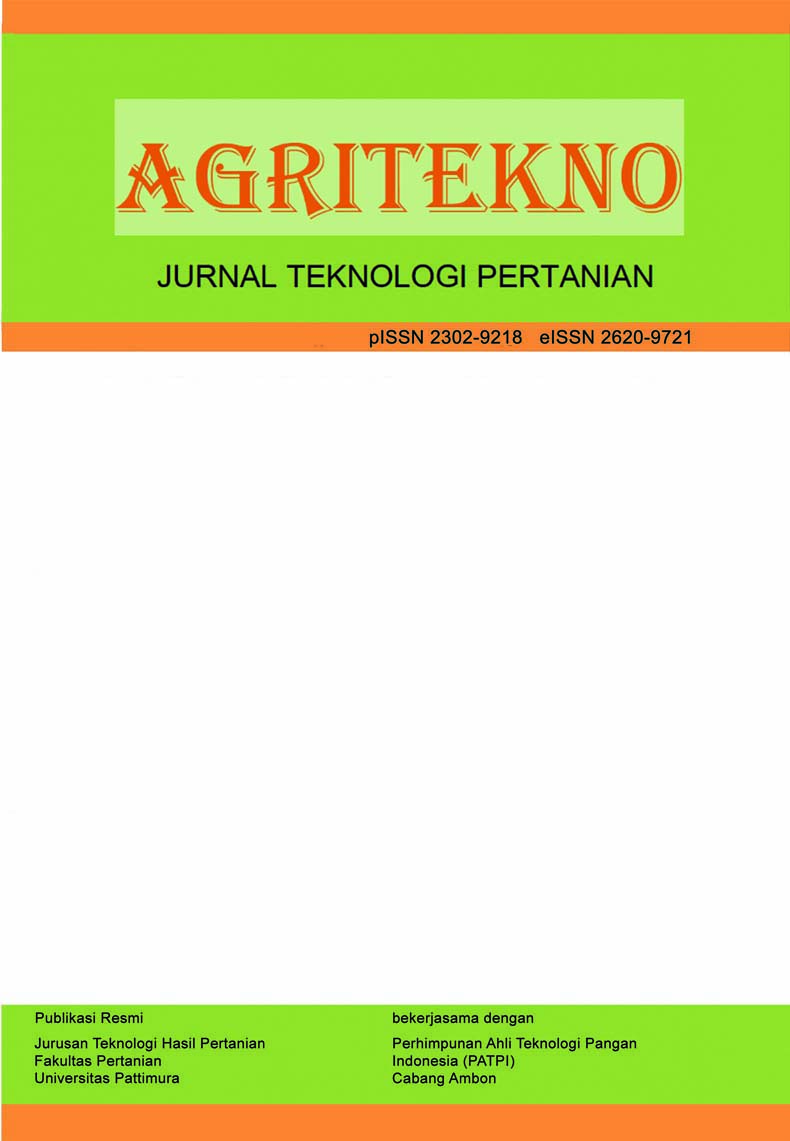Karakteristik Rebon Kering Pada Pembuatan Serundeng Ampas Tahu
Characteristics of Dried Rebon in Making Serundeng Tofu Dregs
Abstract
Tofu dregs are a solid waste generated during the tofu production process, but they can be repurposed as food due to their rich nutritional content, including protein and minerals. One innovative use of tofu pulp is to process it into serundeng (a flaked coconut dish). To enhance the nutritional quality, particularly the protein content, dried shrimp (rebon), which is rich in protein, can be added. This study aims to determine the impact of adding dried shrimp on the moisture content, protein content, yield, and the processing method based on sensory evaluation, such as color, aroma, taste, and texture. The method used was a completely randomized design with four treatments and three replications: A (0% dried shrimp), B (5% dried shrimp), C (10% dried shrimp), and D (15% dried shrimp). Adding dried shrimp significantly affected the moisture and protein content but did not significantly affect the yield. The highest moisture content was found in treatment A (0%) at 18.63% and tended to decrease with the increase of dried shrimp due to its dry nature. Conversely, the protein content increased with the addition of dried shrimp, with the highest value in treatment D (15%) at 26.20%. The highest yield was recorded in treatment C (10%) at 22.77%, but the differences between treatments were not statistically significant. Each attribute showed a different best treatment based on the sensory evaluation results. Treatment A (0%) scored the highest for the color attribute at 4.20, indicating that the panelists preferred the panelists most preferred the product without dried shrimp addition. The best taste was found in treatment D (15%) with a score of 4.27, while the best aroma was found in treatment C (10%) with a score of 4.11. Treatment C (10%) scored the highest for the texture attribute at 4.23, indicating the most preferred texture. Treatment C (10%) was considered the most balanced regarding taste, aroma, and texture, making it the best formulation regarding panelist preference.
Downloads
References
Arsyad, M., Inayah, A.N., & Lasande, A. (2024). Uji organoleptik mutu produk kerupuk terhadap pengaruh penambahan tepung ampas tahu. JASATHP: Jurnal Sains Dan Teknologi Hasil Pertanian, 35-46. https://doi.org/10.55678/jasathp.v4i1.1478
Aprodita, N. (2018). Pengaruh Penambahan Tepung Udang Rebon pada Pembuatan Serundeng Terhadap Daya Terima Konsumen. Doctoral Dissertation, Universitas Negeri Jakarta.
AOAC. (2005). Official of Analysis of The Assiciation of Official Analytical Chemistry, Arlington, AOAC Inc.
AOAC. (2001). Protein (Crude) in Animal Feed, Forage (Plant Tissue), Grain, and Oil seed. J. AOAC Int.
Dara, W. & Fanyalita, A. (2018). Pengaruh substitusi ikan tuna (Thunnus sp.) terhadap mutu organoleptik dan kimia abon jantung pisang (Musa acuminate Balbisiana Colla). Sainstek: Jurnal Sains dan Teknologi, 9(1), 1-7.
Deglas, F.W. (2017). Pengaruh penggunaan tepung ampas tahu terhadap karakteristik kimia dan organoleptik kue stick. Teknologi Pangan: Media Informasi dan Komunikasi Ilmiah Teknologi Pertanian, 8(2), 171-179. https://doi.org/10.35891/tp.v8i2.905
Falah, M.N.A. & Sa’diyah, K. (2024). Pengaruh rasio ampas tahu terhadap kualitas produk pakan ikan nila. DISTILAT: Jurnal Teknologi Separasi, 10(1), 170-179.https://doi.org/10.33795/distilat.v10i1.4215
Fuadi, M., & Arianingrum, W. (2018). Studi pembuatan minuman instan cangkang telur berkalsium tinggi. Agrintech: Jurnal Teknologi Pangan dan Hasil Pertanian, 2(1), 23-32. https://doi.org/10.30596/agrintech.v2i1.2607
Gusnadi, D., Taufiq, R., & Baharta, E. (2021). Uji oranoleptik dan daya terima pada produk Mousse berbasis tapai singkong sebagai komoditi UMKM di Kabupaten Bandung. Jurnal Inovasi Penelitian, 1(12), 2883-2888.
Marhamah, S.U., Akbarillah, T., & Hidayat. (2019). Kualitas nutrisi pakan konsentrat fermentasi berbasis bahan limbah ampas tahu dan ampas kelapa dengan komposisi yang berbeda serta tingkat akseptabilitas pada ternak kambing. Jurnal Sain Peternakan Indonesia, 14(2), 145-153. https://doi.org/10.31186/jspi.id.14.2.145-153
Multazam, F., Kurniasih, R.A., & Anggo, A.D. (2023). Pengaruh rasio tepung udang rebon (Acetes sp.) dan tepung tapioka terhadap karakteristik sensori, fisik dan kimia kerupuk. Jurnal Ilmu dan Teknologi Perikanan, 5(1), 10-18. https://ejournal2.undip.ac.id/index.php/jitpi/article/view/15032
Maryati, M., Keliobas, W., & Kuliahsari, D.E. (2023). Pengaruh penambahan minyak atsiri biji pala terhadap karakteristik organoleptik Abon Ikan Bubara (Caranx sexfasciatus). Jurnal Teknologi Pengolahan Pertanian, 5(1), 33-39. https://doi.org/10.35308/jtpp.v5i1.7028
Martunis, M. (2012). Pengaruh suhu dan lama pengeringan terhadap kuantitas dan kualitas pati kentang varietas granola. Jurnal Teknologi dan Industri Pertanian Indonesia, 4(3), 26-30.https://doi.org/10.17969/jtipi.v4i3.740
Pakaya, R., Mandey, L.C., & Lumoindong, F. (2015). Influence of adding Goroho’s (Musa sp.) banana on nutrient content and organoleptik Tuna shredded (Katsuwonus pelamis). Jurnal Ilmu dan Teknologi Pangan, 3(2), 15-23.
Purba, T.O., Suparmi, & Dahlia. (2020). Studi fortifikasi hidrolisat protein udang rebon (Mysis relicta) pada mie sagu. Jurnal Agroindustri Halal, 6(1), 039-048. https://doi.org/10.30997/jah.v6i1.1819
Purnomo, A.D., Wadli, Purwanti, Y., & Daryono. (2023). Pengaruh penambahan udang rebon kering terhadap peningkatan kandungan protein dan uji organoleptik pada sate aci. Gema Agro, 28(2), 147-154. https://doi.org/10.22225/ga.28.2.8203.147-154
Rachmawati, L. (2016). Pengaruh Penambahan Tepung Kacang Kedelai Terhadap Kadar Protein dan Daya Terima Nugget Udang Rebon. Artikel Ilmiah Hasil Penelitian Mahasiswa. Universitas Jember.
Ramadhani, W., Indrawan, I., & Seveline, S. (2022). Formulasi crackers mocaf dengan penambahan tepung udang rebon serta karakteristiknya. Jurnal Bioindustri, 4(2), 93-108. https://doi.org/10.31326/jbio.v4i2.1238
Sayow, F., Polii, B.V.J., Tilaar, W., & Augustine, K.D. (2020). Analisis kandungan limbah industri tahu dan tempe rahayu di Kelurahan Uner Kecamatan Kawangkoan Kabupaten Minahasa. Agri-Sosioekonomi, 16(2), 245-252.
Suryani, N., Erawati, C.M., & Amelia, S. (2018). Pengaruh proporsi tepung terigu dan tepung ampas tahu terhadap kandungan protein dan serat serta daya terima biskuit program makanan tambahan anak sekolah (PMT-AS). Jurnal Kedokteran dan Kesehatan, 14(1), 11-25. https://doi.org/10.24853/jkk.14.1.11-25
Setiyorini, E.I., & Hadi, S. (2013). Pengaruh penambahan udang rebon dan jamur tiram terhadap hasil jadi kerupuk udang rebon. E-journal Boga, 2(1), 44-50. https://ejournal.unesa.ac.id/index.php/jurnal-tata-boga/article/view/1121
Sutarman, E., Amalia, L., & Putri, D.I. (2024). Pengaruh limbah cair tahu dengan konsentrasi yang berbeda terhadap pertumbuhan tanaman mentimun (Cucumis sativus L.). Jurnal Life Science, 6(1), 27-35. https://doi.org/10.31980/lsciences.v6i1.399
Syarif, W., Holinesti, R., Faridah, A., & Fridayati, L. (2017). Analisis kualitas sala udang rebon. Jurnal Teknologi Pertanian Andalas, 21(1), 45-51. https://doi.org/10.25077/jtpa.21.1.45-51.2017
Van Gobel, R., Naiu, A.S., & Yusuf, N. (2016). Formulasi cookies udang rebon. NIKe: Jurnald Ilmiah Perikanan dan Kelautan, 4(4). https://ejurnal.ung.ac.id/index.php/nike/article/view/5070
Widaningrum, I. (2015). Teknologi pembuatan tahu yang ramah lingkungan (bebas limbah). Jurnal Dedikasi, 12, 14-21. https://ejournal.umm.ac.id/index.php/dedikasi/article/view/2476
Yoka, B.T., & Mardesci, H. (2014). Pengaruh lama perebusan terhadap penerimaan konsumen pada kue berbahan dasar tepung ketan. Jurnal Teknologi Pertanian, 3(2), 43-50. https://doi.org/10.32520/jtp.v3i2.73
Copyright (c) 2025 The Author(s)

This work is licensed under a Creative Commons Attribution-ShareAlike 4.0 International License.
Authors who publish with this journal agree to the following terms:
- Authors retain copyright and grant the journal the right of first publication with the work simultaneously licensed under a Creative Commons Attribution License that allows others to share the work with an acknowledgement of the work's authorship and initial publication in this journal.
- Authors are able to enter into separate, additional contractual arrangements for the non-exclusive distribution of the journal's published version of the work (e.g., post it to an institutional repository or publish it in a book), with an acknowledgement of its initial publication in this journal.
- Authors are permitted and encouraged to post their work online (e.g., in institutional repositories or on their website) prior to and during the submission process, as it can lead to productive exchanges, as well as earlier and greater citation of published work (See The Effect of Open Access).









